Web site designed, created and maintained by Janet Groome,
Handshake Computer Training.
Past Lectures
3 December 2025
Sally Dormer
The Christmas Story in Medieval Art
It was during the Middle Ages that many of the familiar images associated with the
Christmas story were devised and popularized: including the stable in Bethlehem inhabited
by the ox and ass.
What were the sources for these images? Are they always of biblical origin?
This lecture, illustrated by images taken from sources as diverse as illuminated manuscripts,
church portals, liturgical vestments, stained glass windows and goldsmiths’ work, will tell the
stories surrounding Christ’s birth and investigate the often surprising sources for certain
aspects of this well-known narrative.
5 November 25
Anthony Peers
Strictly Classical: The Style of the East India Company
By looking first at Madras, and then Calcutta – there is an opportunity to look at the very
best of the buildings constructed in the heyday of the East India Company.
This lecture touches on the early 17th century origins of the East India Company and
considers the tentative architectural endeavours of the amateur architects and engineers
working at the Company’s behest.
Study is made of Company’s magnificent late 18th and early 19th century classical
buildings, as well as of the stunning late flowering of the Indo Saracenic in Madras and the
remarkable Edwardian Baroque of the Victoria Memorial in Calcutta.
1 October 2025
Jo Walton
Eric Ravilious and the Lure of the Everyday
Ravilious has been described as the greatest English watercolourist of the 20th century and
his images of the landscape and of everyday objects attract passionate devotees.
A prolific painter, printmaker and designer, he became an Official War Artist in 1939, and
was killed in 1942 but his legacy is a body of work reflecting deep delight in the world in
which he lived.
This talk looks at his work and that of some of his contemporaries working on the Home
Front in the Second World War.
2 July 2025
Georgina Bexon
Australian Indigenous Art – 50,000 years ago to the present day
The Australian indigenous people possess probably the oldest continuous culture on our
planet. From the extraordinary early rock and cave art to the modern oil painting, these
artists are great storytellers, passing their mystic culture and sense of the sacred nature of
the landscape down the generations.
This talk investigates the early beginnings of this fascinating art and traces its development
to the modern day where it is exhibited in international galleries and sells for high prices on
the world art market.
4 June 2025
Sue Jackson
The Cultural Heritage of the Huguenots
The Huguenots came to England in huge numbers in the late 17th century bringing a wide
variety of skills - as silk weavers, silversmiths, clock makers, opticians, bankers, gilders,
iron workers, horticulturists etc. Names such as Paul de Lamerie, Samuel Courtauld and
Jean Tijou spring to mind.
In virtually all areas, they were innovators and more advanced than the English who were
forced to improve their own skills or go out of business.
Although the majority settled in London, others found their way to East Anglia, Macclesfield
and Canterbury. This talk examines their lasting legacy.
Wednesday 14 May 2025
Fitzwilliam Museum, Cambridge
Coach departs Radcliffe-on-Trent at 9am, arriving Cambridge at 11am.
Coach departs Cambridge at 4pm, arriving Radcliffe-on-Trent at 6pm.
Entrance ticket to the Fitzwilliam Museum is included.
7 May 2025
Rosamund Bartlett
The Culture of Ukraine – Art, Literature, Music and History
This lecture tells the multifaceted Ukrainian story through the shared culture which binds its
diverse people together, including the sacred art and architecture of Kyiv inherited from
Byzantium, the rich legacy of the Cossacks, and a treasury of poetry, painting and song.
We will also look at the key role played by folk culture in the years before Ukraine's
emergence as an independent nation, whether "red icons" on glass or the country's
remarkable embroidery tradition, which had a surprising influence on avant-garde art.
2 April 2025
Joanne Rhymer
Mary Cassatt (1844-1926) – Painting in Paris
Mary Cassatt was the only American artist to exhibit with the French Impressionists in their
independent exhibitions. When the artist, Edgar Degas, persuaded her to stop exhibiting
work at the Paris Salon - the official art exhibitions in the capital - and to exhibit instead with
his artistic colleagues, she stated that, ‘I accepted with joy… I hated conventional art.’
Cassatt went on to make outstanding contributions to four of the eight Impressionist
exhibitions. Like her Impressionist colleagues, Cassatt represented modern life, but the
subjects suitable for a ‘respectable’ woman such as Cassatt were limited.
Study Day
Wednesday 26th March 2025 at Grange Hall
Chris Aslan
Unravelling the Silk Road
The study day comprises three lectures, each exploring a textile and a road.
We examine how textiles have changed the course of Central Asian history, politics
and a way of life.
We examine how textiles have changed the course of Central Asian history, politics
and a way of life. We also revel in the intoxicating designs, colours, and techniques
achieved with these three textiles, from breath-takingly intricate suzani embroidery
and robes fit for a Shah, to world-class carpets, cheerful shyrdyk felts and
diaphanous cotton, lighter than a spider’s web.
Each lecture will also be embroidered with Chris’s own experience of living and
working in the region for 15 years as he attempts to justify a rather bold assertion,
'that everything is about textiles'.
Now fully booked – contact trentvalleychairman@theartssociety.org to join the
waiting list.’
5 March 2025
Barbara Askew
Charles I – King and Collector – 400th anniversary of his accession
This lecture celebrates the 400th Anniversary of Charles I’s accession to the throne in 1625.
Charles I’s obsession for collecting works of art began when as a 22-year-old prince he
travelled to Spain and saw the magnificent collection of the Spanish king, Philip IV.
On becoming King in 1625 Charles purchased the fabulous collection of the Gonzaga Dukes
of Mantua which included works by Titian, Raphael and Andrea Mantegna’s astonishing
series of paintings “The Triumphs of Caesar”.
5 February 2025
Caroline Bendix
Bound to Learn – a Brief History of Western Bookbinding
This lecture looks at western bookbinding, in particular during the age of the printed book.
Aspects of the book trade, including bookbinding practices and materials used in bindings
are shown and, as structure and decoration changed as the centuries passed, the individual
binders’ fingers tell their own tale as the craft developed.
The bookbinding trade has long recycled waste materials, some of which may be more
valuable than the books themselves. Bookbindings also provide an insight into the owner’s
wealth and station in life, as books were bought unbound and bindings were therefore
generally chosen by the first owner until the 19th century.
8 January 2025
Anne Haworth
The Ming Dynasty – Power, Craftsmanship and Tea in China’s Empire of Brightness
The Ming Dynasty came to power in 1368. Ming translates as bright and the first emperors
of this new dynasty were regarded as semi-divine and blessed by the 'Mandate of Heaven'.
China's new capital city, Beijing, had massive fortified walls which protected the Imperial
Palace - the Forbidden City.
Fine craftsmanship developed under the patronage of the emperors including the making of
glittering gold vessels which reflected the brightness of the new dynasty, brilliantly coloured
red lacquer, jade sculptures and porcelain vessels including the legendary 'Ming Vases'.
Lustrous silk was made into robes and tiny embroidered shoes for ladies with bound 'golden
lotus' feet.









